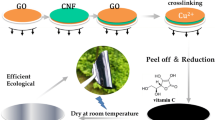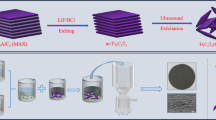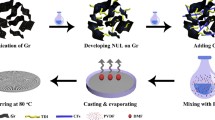Abstract
Developing the polymer-based thermal interface materials (TIMs) is one of the most promising approaches to address heat accumulation along with the functionalization, integration, and miniaturization of modern electronics, while it is still a great challenge to balance the thermal conductivity and mechanical properties. In this article, Fe ion-anchored graphene (FeG) is successfully fabricated by a facile in situ Fe reduction of graphene oxide (GO) approach, and then cellulose nanofibers (CNFs)/FeG composites are prepared by vacuum-assisted filtration. FeG exhibits excellent dispersion and exfoliation in CNFs/FeG composites, due to the strong interfacial interaction between CNFs and FeG, such as hydrogen bonds and “Fe–O” complex binding. Thus, CNFs/FeG composite has the largely improved thermal conductivity up to 30.2 W/mK at FeG content of 50 wt%, which is substantially increased by 1160% in comparison with that of pure CNFs. In addition, the mechanical performances of CNFs/FeG-50 are unexpectedly simultaneously enhanced to 244 MPa for tensile strength, 4.10% for elongation at break, and 9.5 GPa for Young’s modulus, outperforming pure CNFs with increase of 137%, 33%, and 121%, respectively. This study provides a significant strategy for the design and construction of high thermal conductivity and high-performance polymeric TIMs in flexible and portable electronics.
Graphic Abstract










Similar content being viewed by others
References
Balandin AA, Ghosh S, Bao W, Calizo I, Teweldebrhan D, Miao F, Lau CN (2008) Superior thermal conductivity of single-layer graphene. Nano Lett 8:902–907. https://doi.org/10.1021/nl0731872
Chen G, Chen T, Hou K, Ma W, Tebyetekerwa M, Cheng Y, Weng W, Zhu M (2018) Robust, hydrophilic graphene/cellulose nanocrystal fiber-based electrode with high capacitive performance and conductivity. Carbon 127:218–227. https://doi.org/10.1016/j.carbon.2017.11.012
Chen J, Huang X, Zhu Y, Jiang P (2017) Cellulose nanofiber supported 3D interconnected BN nanosheets for epoxy nanocomposites with ultrahigh thermal management capability. Adv Funct Mater 27:1604754. https://doi.org/10.1002/adfm.201604754
Chen X, Lim JSK, Yan W, Guo F, Liang YN, Chen H, Lambourne A, Hu X (2020) Salt template assisted BN scaffold fabrication toward highly thermally conductive epoxy composites. ACS Appl Mater Interfaces 12:16987–16996. https://doi.org/10.1021/acsami.0c04882
Cui P, Lee J, Hwang E, Lee H (2011) One-pot reduction of graphene oxide at subzero temperatures. Chem Commun 47:12370–12372. https://doi.org/10.1039/C1CC15569E
Cui S, Song N, Shi L, Ding P (2020) Enhanced thermal conductivity of bioinspired nanofibrillated cellulose hybrid films based on graphene sheets and nanodiamonds. ACS Sustain Chem Eng 8:6363–6370. https://doi.org/10.1021/acssuschemeng.0c00420
Dong L, Chen Z, Zhao X, Ma J, Lin S, Li M, Bao Y, Chu L, Leng K, Lu H (2018) A non-dispersion strategy for large-scale production of ultra-high concentration graphene slurries in water. Nat Commun 9:1–8. https://doi.org/10.1038/s41467-017-02580-3
Duan H, Zhu H, Gao J, Yan D, Dai K, Yang Y, Zhao G, Liu Y, Li Z (2020) Asymmetric conductive polymer composite foam for absorption dominated ultra-efficient electromagnetic interference shielding with extremely low reflection characteristics. J Mater Chem A 8:9146–9159. https://doi.org/10.1039/D0TA01393E
Fan ZJ, Kai W, Yan J, Wei T, Zhi LJ, Feng J, Ren YM, Song LP, Wei F (2011) Facile synthesis of graphene nanosheets via Fe reduction of exfoliated graphite oxide. ACS Nano 5:191–198. https://doi.org/10.1021/nn102339t
Ferrari AC, Robertson J (2000) Interpretation of Raman spectra of disordered and amorphous carbon. Phys Rev B 61:14095. https://doi.org/10.1103/PhysRevB.61.14095
Geng X, Guo Y, Li D, Li W, Zhu C, Wei X, Chen M, Gao S, Qiu S, Gong Y (2013) Interlayer catalytic exfoliation realizing scalable production of large-size pristine few-layer graphene. Sci Rep 3:1–6. https://doi.org/10.1038/srep01134
Gong S, Zhang Q, Wang R, Jiang L, Cheng Q (2017) Synergistically toughening nacre-like graphene nanocomposites via gel-film transformation. J Mater Chem A 5:16386–16392. https://doi.org/10.1039/C7TA03535G
Guo Y, Yang X, Ruan K, Kong J, Dong M, Zhang J, Gu J, Guo Z (2019) Reduced graphene oxide heterostructured silver nanoparticles significantly enhanced thermal conductivities in hot-pressed electrospun polyimide nanocomposites. ACS Appl Mater Interfaces 11:25465–25473. https://doi.org/10.1021/acsami.9b10161
Guo Y, Ruan K, Gu J (2021) Controllable thermal conductivity in composites by constructing thermal conduction networks. Mater Today Phys 20:100449. https://doi.org/10.1016/j.mtphys.2021.100449
Gu J, Ruan K (2021) Breaking through bottlenecks for thermally conductive polymer composites: a perspective for intrinsic thermal conductivity, interfacial thermal resistance and theoretics. Nano-Micro Lett 13:1–9. https://doi.org/10.1007/s40820-021-00640-4
Hamedi MM, Hajian A, Fall AB, Håkansson K, Salajkova M, Lundell F, Wågberg L, Berglund LA (2014) Highly conducting, strong nanocomposites based on nanocellulose-assisted aqueous dispersions of single-wall carbon nanotubes. ACS Nano 8:2467–2476. https://doi.org/10.1021/nn4060368
Han J, Du G, Gao W, Bai H (2019) An anisotropically high thermal conductive boron nitride/epoxy composite based on nacre-mimetic 3D network. Adv Funct Mater 29:1900412. https://doi.org/10.1002/adfm.201900412
He H, Klinowski J, Forster M, Lerf A (1998) A new structural model for graphite oxide. Chem Phys Lett 287:53–56. https://doi.org/10.1016/S0009-2614(98)00144-4
Hu J, Huang Y, Yao Y, Pan G, Sun J, Zeng X, Sun R, Xu JB, Song B, Wong CP (2017) Polymer composite with improved thermal conductivity by constructing a hierarchically ordered three-dimensional interconnected network of BN. ACS Appl Mater Interfaces 9:13544–13553. https://doi.org/10.1021/acsami.7b02410
Jha PK, Singh SK, Kumar V, Rana S, Kurungot S, Ballav N (2017) High-level supercapacitive performance of chemically reduced graphene oxide. Chem 3:846–860. https://doi.org/10.1016/j.chempr.2017.08.011
Jiang F, Li T, Li Y, Zhang Y, Gong A, Dai J, Hitz E, Luo W, Hu L (2018) Wood-based nanotechnologies toward sustainability. Adv Mater 30:1703453. https://doi.org/10.1002/adma.201703453
Kemp W (2017) Organic spectroscopy. Macmillan International Higher Education, London
Lerf A, He H, Forster M, Klinowski J (1998) Structure of graphite oxide revisited. J Phys Chem B 102:4477–4482. https://doi.org/10.1021/jp9731821
Li G, Tian X, Xu X, Zhou C, Wu J, Li Q, Zhang L, Yang F, Li Y (2017) Fabrication of robust and highly thermally conductive nanofibrillated cellulose/graphite nanoplatelets composite papers. Compos Sci Technol 138:179–185. https://doi.org/10.1016/j.compscitech.2016.12.001
Li J, Zhao X, Wu W, Zhang Z, Xian Y, Lin Y, Lu Y, Zhang L (2020) Advanced flexible rGO-BN natural rubber films with high thermal conductivity for improved thermal management capability. Carbon 162:46–55. https://doi.org/10.1016/j.carbon.2020.02.012
Lu J, Askeland P, Drzal LT (2008) Surface modification of microfibrillated cellulose for epoxy composite applications. Polymer 49:1285–1296. https://doi.org/10.1016/j.polymer.2008.01.028
Luo L, Wu K, Shi J, Du X, Li X, Yang L, Lu M (2017) Green reduction of graphene oxide by polydopamine to a construct flexible film: superior flame retardancy and high thermal conductivity. J Mater Chem A 5:18542–18550. https://doi.org/10.1039/C7TA04740A
Ma T, Zhao Y, Ruan K, Liu X, Zhang J, Guo Y, Yang X, Kong J, Gu J (2019) Highly thermal conductivities, excellent mechanical robustness and flexibility, and outstanding thermal stabilities of aramid nanofiber composite papers with nacre-mimetic layered structures. ACS Appl Mater Interfaces 12:1677–1686. https://doi.org/10.1021/acsami.9b19844
Malho JM, Laaksonen PI, Walther A, Ikkala O, Linder MB (2012) Facile method for stiff, tough, and strong nanocomposites by direct exfoliation of multilayered graphene into native nanocellulose matrix. Biomacromol 13:1093. https://doi.org/10.1021/bm2018189
Meng X, Pan H, Zhu C, Chen Z, Lu T, Xu D, Li Y, Zhu S (2018) Coupled chiral structure in graphene-based film for ultrahigh thermal conductivity in both in-plane and through-plane directions. ACS Appl Mater Interfaces 10:22611–22622. https://doi.org/10.1021/acsami.8b05514
Ni Z, Wang Y, Yu T, Shen Z (2008) Raman spectroscopy and imaging of graphene. Nano Res 1:273–291. https://doi.org/10.1007/s12274-008-8036-1
Park S, Lee KS, Bozoklu G, Cai W, Nguyen ST, Ruoff RS (2008) Graphene oxide papers modified by divalent ions—enhancing mechanical properties via chemical cross-linking. ACS Nano 2:572–578. https://doi.org/10.1021/nn700349a
Park W, Hu J, Jauregui LA, Ruan X, Chen YP (2014) Electrical and thermal conductivities of reduced graphene oxide/polystyrene composites. Appl Phys Lett 104:113101. https://doi.org/10.1063/1.4869026
Ramanathan T, Abdala A, Stankovich S, Dikin D, Herrera-Alonso M, Piner R, Adamson D, Schniepp H, Chen X, Ruoff R (2008) Functionalized graphene sheets for polymer nanocomposites. Nat Nanotechnol 3:327–331. https://doi.org/10.1038/nnano.2008.96
Ren W, Zhu H, Yang Y, Chen Y, Duan H, Zhao G, Liu Y (2020) Flexible and robust silver coated non-woven fabric reinforced waterborne polyurethane films for ultra-efficient electromagnetic shielding. Compos Part B-Eng 184:107745. https://doi.org/10.1016/j.compositesb.2020.107745
Ruan K, Guo Y, Gu J (2021a) Liquid crystalline polyimide films with high intrinsic thermal conductivities and robust toughness. Macromolecules 54:4934–4944. https://doi.org/10.1021/acs.macromol.1c00686
Ruan K, Zhong X, Shi X, Dang J, Gu J (2021b) Liquid crystal epoxy resins with high intrinsic thermal conductivities and their composites: a mini-review. Mater Today Phys 20:100456. https://doi.org/10.1016/j.mtphys.2021.100456
Schiffres SN, Harish S, Maruyama S, Shiomi J, Malen JA (2013) Tunable electrical and thermal transport in ice-templated multilayer graphene nanocomposites through freezing rate control. ACS Nano 7:11183–11189. https://doi.org/10.1021/nn404935m
Scott AI (2013) Interpretation of the ultraviolet spectra of natural products: international series of monographs on organic chemistry. Elsevier, Amsterdams, p 7
Shen X, Wang Z, Wu Y, Liu X, He YB, Kim JK (2016) Multilayer graphene enables higher efficiency in improving thermal conductivities of graphene/epoxy composites. Nano Lett 16:3585–3593. https://doi.org/10.1021/acs.nanolett.6b00722
Shen Z, Feng J (2018) Highly thermally conductive composite films based on nanofibrillated cellulose in situ coated with a small amount of silver nanoparticles. ACS Appl Mater Interfaces 10:24193–24200. https://doi.org/10.1021/acsami.8b07249
Shi X, Zhang R, Ruan K, Ma T, Guo Y, Gu J (2021) Improvement of thermal conductivities and simulation model for glass fabrics reinforced epoxy laminated composites via introducing hetero-structured BNN-30@ BNNS fillers. J Mater Sci Technol 82:239–249. https://doi.org/10.1016/j.jmst.2021.01.018
Song H, Liu J, Liu B, Wu J, Cheng HM, Kang F (2018a) Two-dimensional materials for thermal management applications. Joule 2:442–463. https://doi.org/10.1016/j.joule.2018.01.006
Song N, Pan H, Liang X, Cao D, Shi L, Ding P (2018b) Structural design of multilayer thermally conductive nanofibrillated cellulose hybrid film with electrically insulating and antistatic properties. J Mater Chem C 6:7085–7091. https://doi.org/10.1039/C8TC01277F
Stankovich S, Dikin DA, Dommett GH, Kohlhaas KM, Zimney EJ, Stach EA, Piner RD, Nguyen ST, Ruoff RS (2006) Graphene-based composite materials. Nature 442:282–286. https://doi.org/10.1038/nature04969
Tian S, Sun J, Yang S, He P, Wang G, Di Z, Ding G, Xie X, Jiang M (2016) Controllable edge oxidation and bubbling exfoliation enable the fabrication of high quality water dispersible graphene. Sci Rep 6:34127. https://doi.org/10.1038/srep34127
Uetani K, Okada T, Oyama HT (2016) Thermally conductive and optically transparent flexible films with surface-exposed nanocellulose skeletons. J Mater Chem C 4:9697–9703. https://doi.org/10.1039/C6TC03318K
Wan S, Fang S, Jiang L, Cheng Q, Baughman RH (2018) Strong, conductive, foldable graphene sheets by sequential ionic and π bridging. Adv Mater 30:1802733. https://doi.org/10.1002/adma.201802733
Wu D, Gao X, Sun J, Wu D, Liu Y, Kormakov S, Zheng X, Wu L, Huang Y, Guo Z (2017) Spatial confining forced network assembly for preparation of high-performance conductive polymeric composites. Compos Part A-Appl S 102:88–95. https://doi.org/10.1016/j.compositesa.2017.07.027
Wu Z, Xu C, Ma C, Liu Z, Cheng HM, Ren W (2019) Synergistic effect of aligned graphene nanosheets in graphene foam for high-performance thermally conductive composites. Adv Mater 31:1900199. https://doi.org/10.1002/adma.201900199
Xu X, Chen J, Zhou J, Li B (2018a) Thermal conductivity of polymers and their nanocomposites. Adv Mater 30:1705544. https://doi.org/10.1002/adma.201705544
Xu Y, Sheng K, Li C, Shi G (2010) Self-assembled graphene hydrogel via a one-step hydrothermal process. ACS Nano 4:4324–4330. https://doi.org/10.1021/nn101187z
Xu Y, Yang Y, Yan D, Duan H, Zhao G, Liu Y (2018b) Gradient structure design of flexible waterborne polyurethane conductive films for ultraefficient electrimagnetic shielding with low reflection characteristic. ACS Appl Mater Interfaces 10:19143–19152. https://doi.org/10.1021/acsami.8b05129
Yang W, Gong Y, Zhao X, Liu T, Zhang Y, Chen F, Fu Q (2019) Strong and highly conductive graphene composite film based on the nanocellulose-assisted dispersion of expanded graphite and incorporation of poly (ethylene oxide). ACS Sustain Chem Eng 7:5045–5056. https://doi.org/10.1021/acssuschemeng.8b05850
Yang W, Zhao Z, Wu K, Huang R, Liu T, Jiang H, Chen F, Fu Q (2017) Ultrathin flexible reduced graphene oxide/cellulose nanofiber composite films with strongly anisotropic thermal conductivity and efficient electromagnetic interference shielding. J Mater Chem C 5:3748–3756. https://doi.org/10.1039/C7TC00400A
Yao Y, Zeng X, Wang F, Sun R, Xu JB, Wong CP (2016) Significant enhancement of thermal conductivity in bioinspired freestanding boron nitride papers filled with graphene oxide. Chem Mater 28:1049–1057. https://doi.org/10.1021/acs.chemmater.5b04187
Yao Y, Zhu X, Zeng X, Sun R, Xu JB, Wong CP (2018) Vertically aligned and interconnected SiC nanowire networks leading to significantly enhanced thermal conductivity of polymer composites. ACS Appl Mater Interfaces 10:9669–9678. https://doi.org/10.1021/acsami.8b00328
Yuan W, Zhou Y, Li Y, Li C, Peng H, Zhang J, Liu Z, Dai L, Shi G (2013) The edge-and basal-plane-specific electrochemistry of a single-layer graphene sheet. Sci Rep 3:2248. https://doi.org/10.1038/srep02248
Zhang Y, Peng J, Li M, Saiz E, Wolf SE, Cheng Q (2018) Bioinspired supertough graphene fiber through sequential interfacial interactions. ACS Nano 12:8901–8908. https://doi.org/10.1021/acsnano.8b04322
Zhao L, Roh K, Kacmoli S, Kurdi KA, Jhulki S, Barlow S, Marder SR, Gmachl C, Rand BP (2020) Thermal management enables bright and stable perovskite light-emitting diodes. Adv Mater 32:2000752. https://doi.org/10.1002/adma.202000752
Zhao X, Gao W, Yao W, Jiang Y, Xu Z, Gao C (2017) Ion diffusion-directed assembly approach to ultrafast coating of graphene oxide thick multilayers. ACS Nano 11:9663–9670. https://doi.org/10.1021/acsnano.7b03480
Zhuo H, Zhang H, Wang L, Lu Q, Kaplan DL (2018) Sonication exfoliation of defect-free graphene in aqueous silk nanofiber solutions. ACS Sustain Chem Eng 6:12261–12267. https://doi.org/10.1021/acssuschemeng.8b02644
Acknowledgments
This work was supported by the National Natural Science Foundation of China (NSFC No. 51663003); Science and Technology Foundation of Guizhou Province (Grant No. [2019] 2166).
Author information
Authors and Affiliations
Corresponding author
Ethics declarations
Conflict of interest
We have no conflicts of interest to declare that are relevant to the content of this article. We certify that they have no affiliations with or involvement in any organization or entity with any financial interest or non-financial interest in the subject matter or materials discussed in this manuscript. We have no financial or proprietary interests in any material discussed in this article.
Human and animal rights
This article does not contain any studies with human participants or animals performed by any of the authors. All the experiments were undertaken in this study comply with the current laws of the country where they were performed.
Data availability
All data generated or analyzed during this study are included in this published article.
Additional information
Publisher's Note
Springer Nature remains neutral with regard to jurisdictional claims in published maps and institutional affiliations.
Rights and permissions
About this article
Cite this article
Shan, B., Xiong, Y. Controllable Fe ion-anchored graphene heterostructures for robust and highly thermal conductive cellulose nanofiber composites. Cellulose 28, 10305–10319 (2021). https://doi.org/10.1007/s10570-021-04202-0
Received:
Accepted:
Published:
Issue Date:
DOI: https://doi.org/10.1007/s10570-021-04202-0




